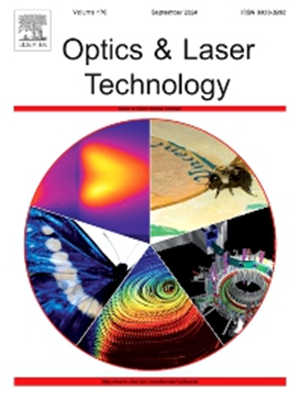High-performance multispectral ghost imaging based on the sine–cosine optimized patterns
IF 4.6
2区 物理与天体物理
Q1 OPTICS
引用次数: 0
Abstract
In recent years, the recovery of multispectral target scene has garnered increasing attentions from researchers, leading to the development of a series of ghost imaging schemes. However, the existing schemes still possess limitations such as requiring a large number of measurements and subpar performance. Therefore, here, we propose a deep-learning driven multispectral ghost imaging (MGI) scheme based on the sine–cosine optimized patterns (SCOP) for high-efficiency MGI. This scheme adopts a modified pattern selection strategy and relies on the powerful feature-extraction and representation-learning capabilities of multi-scale colour mapping (MSCM) network, which promise high-efficiency MGI for the multispectral target scenes. Experimental results show that the proposed MGI scheme can reconstruct complex multispectral target scenes with high quality at an ultra-low sampling rate (SR) of 2 %. In addition, the proposed scheme has excellent anti-noise performance and performs well in low signal-to-noise ratio (SNR) of 10 dB conditions. Overall, it provides a reliable solution for achieving fast high-quality MGI.
基于正余弦优化图案的高性能多光谱鬼影成像技术
近年来,多光谱目标场景的复原受到越来越多研究人员的关注,并由此开发出一系列鬼影成像方案。然而,现有方案仍存在需要大量测量和性能不佳等局限性。因此,我们在此提出一种基于正弦余弦优化模式(SCOP)的深度学习驱动的多光谱鬼影成像(MGI)方案,以实现高效的多光谱鬼影成像。该方案采用改进的模式选择策略,并依赖于多尺度颜色映射(MSCM)网络强大的特征提取和表征学习能力,有望实现多光谱目标场景的高效 MGI。实验结果表明,所提出的 MGI 方案能以 2% 的超低采样率 (SR) 高质量地重建复杂的多光谱目标场景。此外,提出的方案还具有出色的抗噪性能,在信噪比(SNR)为 10 dB 的低噪声条件下也表现出色。总之,它为实现快速高质量 MGI 提供了可靠的解决方案。
本文章由计算机程序翻译,如有差异,请以英文原文为准。
求助全文
约1分钟内获得全文
求助全文
来源期刊
CiteScore
8.50
自引率
10.00%
发文量
1060
审稿时长
3.4 months
期刊介绍:
Optics & Laser Technology aims to provide a vehicle for the publication of a broad range of high quality research and review papers in those fields of scientific and engineering research appertaining to the development and application of the technology of optics and lasers. Papers describing original work in these areas are submitted to rigorous refereeing prior to acceptance for publication.
The scope of Optics & Laser Technology encompasses, but is not restricted to, the following areas:
•development in all types of lasers
•developments in optoelectronic devices and photonics
•developments in new photonics and optical concepts
•developments in conventional optics, optical instruments and components
•techniques of optical metrology, including interferometry and optical fibre sensors
•LIDAR and other non-contact optical measurement techniques, including optical methods in heat and fluid flow
•applications of lasers to materials processing, optical NDT display (including holography) and optical communication
•research and development in the field of laser safety including studies of hazards resulting from the applications of lasers (laser safety, hazards of laser fume)
•developments in optical computing and optical information processing
•developments in new optical materials
•developments in new optical characterization methods and techniques
•developments in quantum optics
•developments in light assisted micro and nanofabrication methods and techniques
•developments in nanophotonics and biophotonics
•developments in imaging processing and systems

 求助内容:
求助内容: 应助结果提醒方式:
应助结果提醒方式:


